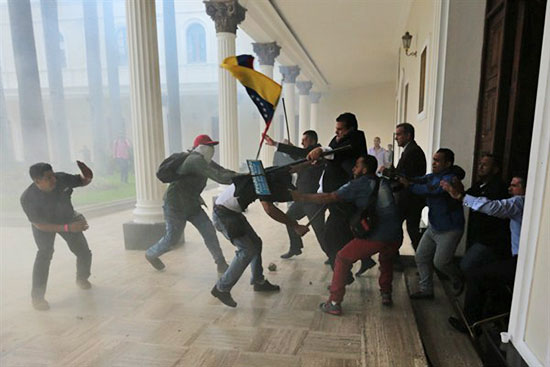|
by Judah Grunstein July 26, 2017 from WorldPoliticsReview Website
Venezuelan opposition lawmakers brawl with pro-government militias at the National Assembly, Caracas, July 5, 2017 (AP photo by Fernando Llano).
SANTIAGO, Chile
Imagine an Obama administration official looking out at the world from the vantage point of December 2015.
The Middle East is engulfed in bloody conflict and crackdowns on domestic dissent. Africa is muddling through a humbling correction to the “success story” narrative that had been used to portray the continent's preceding decade of dynamic growth and democratic progress.
Asia
is an uneasy landscape of shifting power balances and wary
hedging in the shadow of a newly aggressive China. And Europe is
struggling to address a refugee and migrant crisis that is
awakening a populist backlash to elite consensus.
Driven by China's demand for commodities, the region had just ridden a wave of prosperity that swelled the ranks of a burgeoning middle class.
Left-wing governments in,
...had used progressive approaches to redistributive policy
to dramatically reduce poverty and expand access to health care
and education.
Argentina's presidential election, won by
Mauricio Macri on a
program of structural reforms, suggested popular fatigue with
the personalized rule and economic chaos of Cristina Fernandez
de Kirchner's leftist government.
But when Obama took office in 2008, America's political capital in Latin America had been depleted by eight years of George W. Bush's historically tone-deaf approach.
The Obama administration
restored Washington's legitimacy and credibility through a
combination of hands-off noninterference and its bold initiative
to begin normalizing ties with Cuba in December 2014.
Brazil was no longer a regional leader but a champion of the Global South on the world stage.
The countries of South America were as likely to look west to Asia as north to the U.S. for trade, investment and aid. And with the notable exception of Venezuela - and, to a lesser extent, Ecuador and Bolivia - the continent was a model of democratic expansion and consolidation.
The ongoing political circusin Brazil and Venezuela'sdescent into dictatorship, famine and chaosthreaten to further derail the region.
A year and a half later, the South American political landscape is considerably more unstable, to the point of being almost unrecognizable.
Things are far from doom and gloom, particularly compared to the violence in the Middle East and geopolitical tensions in Eastern Europe and Asia.
...have managed to register growth despite the commodities bust.
Argentina continues its uneven and painful corrections to the
Fernandez era's policy mismanagement, while Colombia continues
to implement its peace accord with the FARC in fits and starts.
The transnational corruption scandal involving the Brazilian construction firm Odebrecht has rippled outward to implicate the political class of the entire region.
Most recently, former Peruvian President Ollanta Humala was charged, along with his wife, with receiving illegal campaign donations from the firm in 2011 and ordered to await the outcome of the investigation in jail.
In Chile, unrelated corruption charges against the son of President Michelle Bachelet tainted her second nonconsecutive term, and unsatisfying reforms to education and retirement pensions have driven more popular disenchantment with the center-left, but also the country's political elite more generally.
In Argentina, too, there is a
sense of impending trouble, as proponents of painful structural
reforms begin to realize that the resulting benefits are
unlikely to fully kick in before parliamentary elections in
October.
It's hard to understate the extent of Brazil's reversal of fortune over the past year and a half.
Its economy, like those
of most of the commodity-exporting countries of South America,
had already weakened by December 2015. And popular
dissatisfaction with former President Dilma Rousseff was already
on display at the 2014 World Cup, where she was humiliated with
a shower of boos from the home crowd.
Its role as an emerging global power has been all but forgotten.
Its role as a regional leader - on anything other than
corruption - has likewise been torpedoed.
That has implications
for neighboring Colombia, which could face a destabilizing flood
of refugees at a vulnerable moment for the ongoing
implementation of its peace accord.
For a host of reasons, the U.S. should address Venezuela's crisis in concert with South American partners, and ideally by letting South American countries take the lead themselves.
In 2008, 2009 and 2010, Brazil played a central role in resolving repeated tensions between Colombia and Venezuela that at one point in 2008 saw then-President Chavez deploy tanks to the border.
As recently as October 2015, the
regional body UNASUR
helped mediate border tensions between the two neighbors.
Under normal circumstances, Washington would be paying closer attention, but clearly these are not 'normal times'...
|


